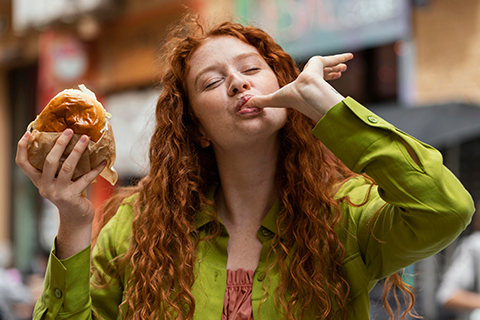
What Is Emotional Eating? – Psychology Behind It

Y
ou are up against deadlines, in back-to-back meetings, eating lunch at your desk when suddenly, you find yourself reaching into your desk only to discover a half-empty bag of chips! You were not even hungry...so what compelled you to eat them?
Enter emotional eating - an automatic habit that relates to our most chaotic days and overwhelming moments. Whether it's binging on snacks at 11am in the morning, or again polishing off a doughnut at 3 PM to pull yourself together, emotional eating is not about hunger, it's about coping.
This blog looks into the psychology of emotional eating - why it exists, how it shows up in everyday life and approaches to break away from this cycle.
Also Read: How To Start Eating Healthy?
So, What Exactly Is Emotional Eating?

At its most basic level, emotional eating is when we resort to food not because we are hungry for food, but rather to soothe, distract from, or react to feelings and emotions. It is eating motivated by feelings and emotions, rather than to fuel.
Consider it this way: You are not eating because your stomach is growling. You are eating because you have a million emails to get to, your boss has just thrown a last-minute assignment at you, or you are feeling lonely after a long day. This type of eating happens pretty regularly, right? Unlike physical hunger which develops over time and can be satisfied with just about anything, emotional hunger is sudden, very specific and it often comes with guilt or regret.
Also Read: Mindful Eating For Athletes – How To Reconnect With Food?
Why It’s So Common In Hectic Lives?

Our lives are increasingly busy, and with the culture of hustle, many of us are running on auto-pilot rather than processing how we are impacted by things we experience. We eat lunch and sometimes dinner at our desk, we skip meals, and we reward ourselves with dinner when we’ve had a long day. If you’ve also added sleep deprivation, decision fatigue and a constantly activated digital world, it is easy to go to food for a quick solution to distract yourself. On top of that, we’ve been trained from childhood that food experience was a rewarding and comfort-giving act: birthday cake, formal family dinners, “treat” after a long hard day, which can easily create an association with broken emotional states and snacking.
Also Read: Side Effects of Eating Too Much Protein
The Psychology Behind Emotional Eating:
Food consumption during emotional moments appears to result from a multi-layered coping strategy based on past experience and emotional control methods.
What happens behind the scenes during emotional eating?
The Emotional Eating Cycle

The majority of emotional eating behaviour occurs through an established pattern:
1. Emotional Trigger: The first stage begins with an emotional trigger that can be either positive or negative.
2. Craving For Comfort Food: Following the emotional trigger, people experience cravings for food which contains high sugar, high fat, and high carbohydrate content.
3. Temporary Relief: The emotion receives brief relief from food consumption before the sensation disappears.
4. Post-Eating Guilt – Feelings of regret, shame, or frustration. The habit leads to repeating the cycle when your emotions rise. 5. Repetition: With time the brain forms an enduring connection between eating and emotional relief even though the relief lasts only briefly.
Also Read: Clean Bulking Vs Dirty Bulking
Stress, Cortisol & Cravings

Your body produces cortisol during stressful situations such as impending deadlines and relationship conflicts or a busy day which serves as the stress hormone. The hormone cortisol stimulates your appetite while triggering strong desires for comfort foods that provide rapid relief. The brain's reward center activates when eating these foods which releases dopamine for a brief emotional satisfaction. Repeated use of food for emotional coping strengthens your brain's habit formation system which creates an increasing difficulty to stop the pattern.
Also Read: Top 10 Myths On Whey Protein
Personality Traits & Emotional Triggers
Several psychological characteristics increase the likelihood of emotional eating behaviour:
• Impulsivity – People who act on their cravings without considering the consequences.
• Low emotional awareness – People who cannot recognize or describe their feelings tend to use food as their primary response.
• Reward sensitivity – People who experience stronger reactions to the mood-enhancing properties of food.
• Restrained eating – People who diet strictly tend to develop emotional eating tendencies when their control breaks down.
Also Read: What Makes a Protein High-Quality Protein?
Cognitive Reappraisal
Individuals who eat emotionally typically lack cognitive reappraisal which allows them to reframe challenging situations. People experiencing a bad day typically view it as a failure instead of a learning opportunity which triggers emotional distress that leads to using food as comfort.
Why It Feels Automatic?

The practice of emotional eating transforms into an automatic behaviour through time. You might not even notice the act until you find the snack empty. The brain has developed the understanding that food provides comfort during bad emotions. We need to break this pattern because it develops into an automatic reaction.
The first step to regaining control over your eating habits requires understanding the difference between emotional hunger and physical hunger since it determines which one drives your cravings in a fast-paced stress-filled lifestyle.
Emotional Hunger vs Physical Hunger: How to Tell the Difference?
|
Clue |
Physical Hunger |
Emotional Hunger |
|
Onset |
Gradual |
Sudden and urgent |
|
Cravings |
Open to various foods |
Specific comfort foods (e.g., sweets, chips) |
|
Location |
Felt in the stomach (growling, emptiness) |
Felt in the mind or chest (stress, boredom) |
|
Satisfaction |
Stops when full |
May persist even after eating |
|
Emotions After Eating |
Contentment |
Guilt, regret, or shame |
|
Timing |
Occurs several hours after a meal |
Can happen anytime, even when full |
Sudden food cravings without hunger usually indicate that emotional hunger is trying to get attention.
Also Read: The Best Plant Protein Supplements in India
Practical Strategies to Break the Cycle
The following steps will help you transform mindless eating into conscious nutritional intake:
1. Pause & Check In
Before you grab food, ask yourself whether your body requires nourishment or if you experience other feelings. Prior to eating check your hunger level using a scale which ranges from 1 (starving) to 10 (stuffed).
2. Practice the 5-Minute Rule
Try postponing your food intake by five minutes. Take this time to breathe deeply, stretch, or sip water. The emotional hunger usually disappears which leads to the disappearance of food cravings.
3. Name the Emotion
Food should not be used to suppress emotions so attempt to identify what you are feeling by saying “I feel anxious” or “I feel overwhelmed” or “I feel bored.” When you give your emotions a name you become able to handle them better.
4. Find Non-Food Coping Tools
Make a list of different tools which you can use instead of food: • Take a walk • Call a friend • Listen to music • Journal • Do a quick workout or meditation.
5. Eat Mindfully
Chew thoroughly. Take time to experience the tastes. This process helps your body understand when it has enough food which leads to less overeating.
Next time, before reaching for a snack you should stop and question whether you are satisfying physical hunger or emotional needs…
Your response could change the way you eat and your entire lifestyle. Food should serve as physical sustenance rather than emotional comfort…
Reference:
https://pmc.ncbi.nlm.nih.gov/articles/PMC7663318/
Also Read: Creamy Vs Crunchy Peanut Butter
 Follow our Instagram page for the latest updates: badalkhudko
Follow our Instagram page for the latest updates: badalkhudko




Leave a comment